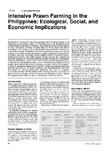Intensive prawn farming in the Philippines: ecological, social, and economic implications
Share
Abstract
The benefits of intensive farming of the giant tiger prawn Penaeus monodon in the Philippines are discussed in relation to the environmental costs. Ecological effects include mangrove conversion into ponds; use of antibiotics and chemicals leading to drug resistance; dumping of pond effluents which affect neighboring ecosystems; and pumping of groundwater that causes saltwater intrusion and vulnerability to floods. In addition, these effects lead to social costs in the form of reduction in domestic and agricultural water supplies; decreases in the production of foodfish and other food crops; further marginalization of coastal fishermen; displacement of labor; and credit monopoly by big businessmen. Comparative economic analyses of three prawn-farming systems showed that, compared to extensive and intensive culture, semi-intensive farms give the best performance using undiscounted (payback period, return on investment) and discounted (net present value, internal rate of return) economic indicators. With a 20% fluctuation in inputs or selling price intensive farming will no longer be profitable because of the high variable cost. The paper concludes with recommendations for strict enforcement of existing government guidelines (e.g. ban on mangrove conversion); institution of new policies on the use of groundwater, seawater and public credit; diversification of cultured species; and emphasis on semi-intensive farming parallel with brakes on further intensification of prawn farming.
Suggested Citation
Primavera, J. (1991). Intensive prawn farming in the Philippines: ecological, social, and economic implications. AMBIO: A Journal of the Human Environment , 20(1), 28-33. http://hdl.handle.net/10862/1342
Subject
Taxonomic term
Collections
- AQD Journal Articles [1249]



